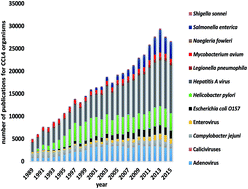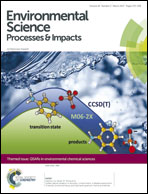Virulence factor activity relationships (VFARs): a bioinformatics perspective
Abstract
Virulence factor activity relationships (VFARs) – a concept loosely based on quantitative structure–activity relationships (QSARs) for chemicals was proposed as a predictive tool for ranking risks due to microorganisms relevant to water safety. A rapid increase in sequencing capabilities and bioinformatics tools has significantly increased the potential for VFAR-based analyses. This review summarizes more than 20 bioinformatics databases and tools, developed over the last decade, along with their virulence and antimicrobial resistance prediction capabilities. With the number of bacterial whole genome sequences exceeding 241 000 and metagenomic analysis projects exceeding 13 000 and the ability to add additional genome sequences for few hundred dollars, it is evident that further development of VFARs is not limited by the availability of information at least at the genomic level. However, additional information related to co-occurrence, treatment response, modulation of virulence due to environmental and other factors, and economic impact must be gathered and incorporated in a manner that also addresses the associated uncertainties. Of the bioinformatics tools, a majority are either designed exclusively for virulence/resistance determination or equipped with a dedicated module. The remaining have the potential to be employed for evaluating virulence. This review focusing broadly on omics technologies and tools supports the notion that these tools are now sufficiently developed to allow the application of VFAR approaches combined with additional engineering and economic analyses to rank and prioritize organisms important to a given niche. Knowledge gaps do exist but can be filled with focused experimental and theoretical analyses that were unimaginable a decade ago. Further developments should consider the integration of the measurement of activity, risk, and uncertainty to improve the current capabilities.

- This article is part of the themed collection: QSARs and computational chemistry methods in environmental chemical sciences


 Please wait while we load your content...
Please wait while we load your content...